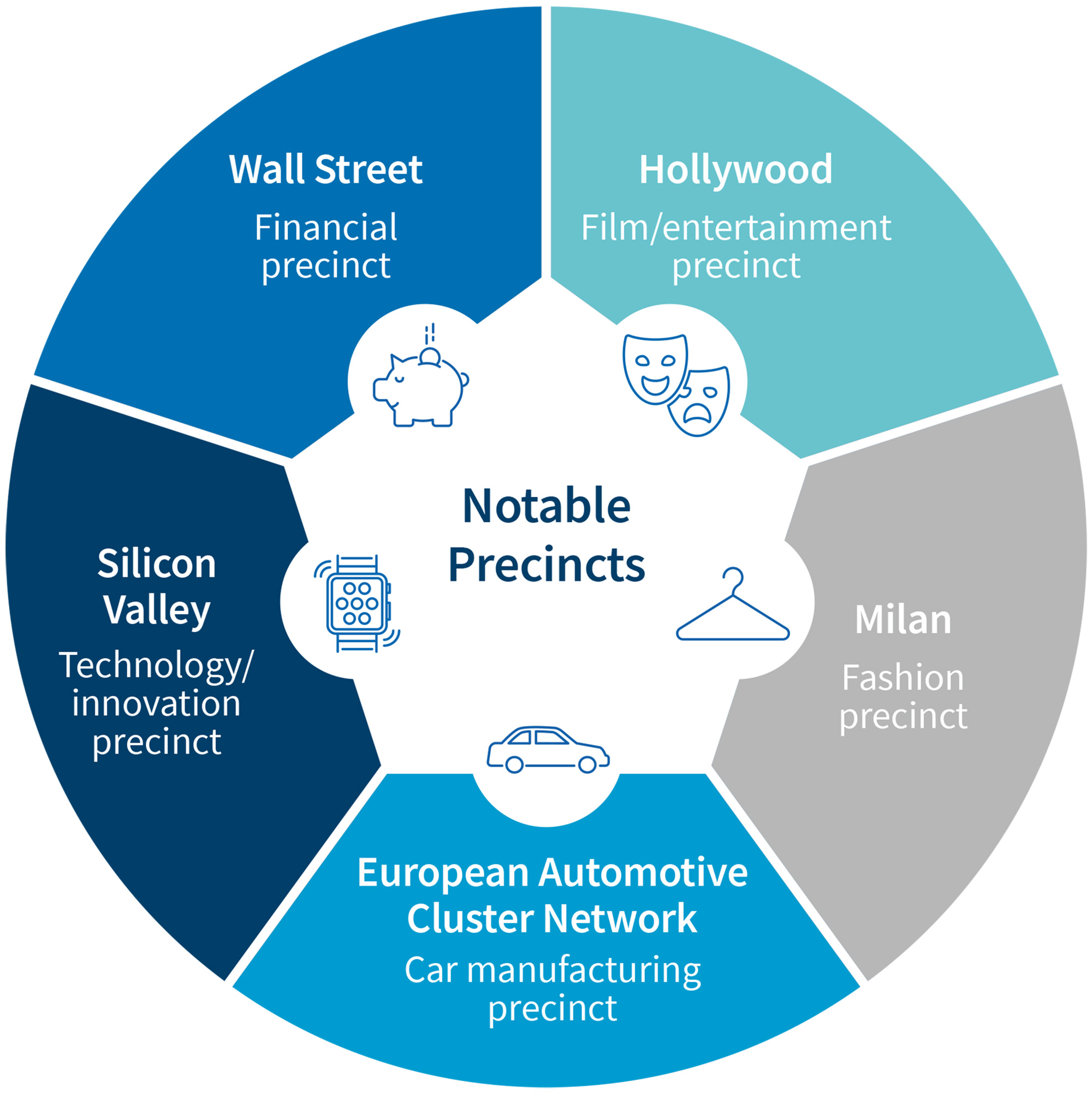- Accueil
- / Publications
- / Articles
- / What Makes a Good Precinct?
What Makes a Good Precinct?
Insights Series on the Role That Precincts Play in Evolving the Urban Landscape and Growing Industries and Economies
-
novembre 21, 2023
TéléchargezDownload Article
-
A precinct is a complex and coordinated system that, with the help of public and private investment, drives innovation and fosters growth. However, identifying and developing a precinct is not always as simple as drawing a line on a map – to be successful, it often needs to be built on a foundation of natural industry growth and agglomeration.
What is a Precinct?
An economic precinct (sometimes called a cluster) is a place where businesses in related industries utilise proximity, collaboration and networks to increase their profit. Correspondingly, precincts are associated with a range of positive economic outcomes, such as employment growth, productivity, wages and even foreign investment.1, 2
Precincts are everywhere – some of the most notable precincts include:

Competition and cooperation work in tandem for business success
Precincts improve the chances of success for businesses by utilising both competition and cooperation to drive productivity growth. Businesses in precincts become more productive through:
- lower supply chain costs
- improved access to labour and lower hiring costs
- greater access to consumers.
However, businesses are not the only beneficiaries of precincts. Suppliers, employees and consumers also enjoy advantages, and therefore, with so many parties impacted, governments have an interest in helping precincts to succeed. Tangible benefits of precincts that are of interest to governments include increased productivity, increased regional competitiveness and higher average wages.3
Supply chain improvements benefit suppliers
Agglomeration incentivises suppliers to an industry to locate themselves near the cluster to take advantage of a larger and closer customer base. This increases the ability of the firms in the cluster to specialise and develop comparative advantage. This also reduces shipping costs for firms, by reducing the need to ship goods long distances or import from overseas. Cooperation of firms in the transport of intermediate goods also reduces costs.
Labour markets are more competitive
Precincts often develop around a strong, pre-existing concentration of skilled labour sought by an industry. This attracts more specialised workers and gives businesses easier access to their knowledge and ideas.
Consumers enjoy easier access to goods and services
When businesses cluster together, consumers benefit from easier access to similar products and services. A shopping mall is an example of a cluster of businesses offering similar products.
Consumers benefit from reduced search and transaction costs as they can travel to a single location to access a greater variety of options. This allows consumers to more easily find the specific good or service they require.
Precincts need a foundation – they are not a circle on a map
Precinct success comes from developing a sustainable set of strengths. These strengths may be a skilled labour force, one or more influential anchor firms that attract other firms to the precinct, or locational advantage. However, for precinct longevity and prosperity, these strength indicators typically must be present prior to government involvement.
Malaysia’s BioValley, now referred to by some as the Valley of Ghosts, is an example of an unsuccessful top-down approach to precinct planning. The vision was for the precinct to drive Malaysia to be a global leader in biotechnology. However, the location lacked many of the attributes necessary for a successful precinct; there were no large firms in the biotech industry, nor any notable labour force. BioValley was unsuccessful in attracting industrial labs, facilities or skilled labour and never opened.4
A precinct cannot be created by drawing a circle on a map – a successful precinct develops in a region that has strong fundamentals.
For instance, Sydney’s Connect Macquarie Park Innovation District (ConnectMPID) is an innovation precinct comprising over 15 businesses and organisations, including the New South Wales Government and Macquarie University.5 However, ConnectMPID was not formed until after these businesses were established in the area. Using a bottom-up approach, the foundation developed naturally first, then the ‘circle was drawn’ linking the university and the WiSE Specialist Emergency Clinic (among other businesses) – establishing ConnectMPID to connect businesses and innovators with opportunities for economic growth.
How we can help you identify a precinct
Precincts are complex structures, with their success likely to vary based on location and industry. However, success is influenced by a reasonably well-known set of factors, including:
- Deep labour force –a large proportion of labourers with skillsets unique to an industry
- Anchor tenants – large firms, universities or hospitals that attract other firms and can facilitate skill transfer between firms
- Infrastructure – access to low-cost, reliable inputs such as energy, resources and water, and infrastructure to create pathways to market (e.g., sufficient access to shipping systems)
- Supporting policy – a framework that favourably influences the key drivers of precinct success.
At FTI Consulting, our Economic & Financial Consulting team applies the tools from our PrecinctIQ tool kit to your specific industry to help identify challenges and opportunities during your precinct’s development cycle. Our tool kit can identify potential precinct sites and assess the strengths and opportunities of sites with the development goals of your region.
Footnotes:
1: Ketels, C. and Memedovic, O. “From clusters to cluster-based economic development”, International Journal of Technological Learning Innovation and Development, February 2008.
2: Slaper, T. and Zheng, P. “Competitive advantage, industry clusters and the magnetic attraction of investment in new plant and equipment from outside the region”. Kelley School of Business Research Paper No. 18-69, August 2018.
3: Ketels, C. and Memedovic, O. “From clusters to cluster-based economic development”, International Journal of Technological Learning Innovation and Development, February 2008.
4: Cyranoski, D. “The valley of ghosts”, Nature, 436, 620-621, 3 August 2005.
5: Macquarie Park Innovation District, “https://www.connectmpid.com.au/about-us” About Us.
Related Insights
Date
novembre 21, 2023
 Contacts
Contacts
Managing Director
Director
Senior Director
Senior Director


